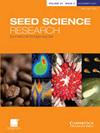丁香醛是一种新型的烟源性催芽剂,可用于当地的追火烟草——衰减烟草
IF 1.9
3区 生物学
Q2 PLANT SCIENCES
引用次数: 3
摘要
摘要烟雾衍生的种子发芽是植物在火灾后栖息地定居的一个重要特征。karrikins的烟雾衍生化学物质可以发芽,这些种子是自然界火灾后未知的物种。因此,火灾后原生植物在烟雾中的生态相关发芽线索仍有待探索。对于火灾追逐者,衰减烟草,我们重新审视了生物测定驱动的液体烟雾分级,以确定与生态相关的发芽线索。通过将生物测定引导的分级和比较无偏代谢组学相结合,我们开发了一种稳健有效的方法来识别烟雾中的发芽线索。丁香醛(SAL)被重新鉴定为促进种子发芽的液体烟雾组分中的发芽线索。SAL被发现是在植物原生栖息地的野火期间产生的,它从水溶液中有效地吸附到衰减N.defuta种子上,不容易从土壤中浸出,并准确预测了自然火灾事件的边界,反映了原生火灾后衰减N.defita种群的发生。我们认为SAL是该物种在烟雾中的生态相关发芽线索。本文章由计算机程序翻译,如有差异,请以英文原文为准。
Syringaldehyde is a novel smoke-derived germination cue for the native fire-chasing tobacco, Nicotiana attenuata
Abstract Smoke-derived seed germination is an important trait for plants to colonize postfire habitats. The well-characterized smoke-derived chemicals of karrikins germinate seeds of species not known to occur after fires in nature. Hence, the ecologically relevant germination cues in smoke remain to be explored for native postfire plants. With the fire-chaser, Nicotiana attenuata, we revisit a bioassay-driven fractionation of liquid smoke to identify ecologically relevant germination cues. By combining bioassay-guided fractionation and comparative unbiased metabolomics, we developed a robust and efficient method to identify germination cues in smoke. Syringaldehyde (SAL) was re-identified as a germination cue in fractions of liquid smoke that promote seed germination. SAL was found to be produced during wildfires in the plant's native habitat, efficiently adsorbed to N. attenuata seeds from aqueous solutions and not readily leached from soil and accurately predicted the boundaries of natural fire events that reflect the occurrence of native postfire N. attenuata populations. We propose that SAL is an ecologically relevant germination cue in smoke for this species.
求助全文
通过发布文献求助,成功后即可免费获取论文全文。
去求助
来源期刊

Seed Science Research
生物-植物科学
CiteScore
3.60
自引率
4.80%
发文量
23
审稿时长
>12 weeks
期刊介绍:
Seed Science Research, the official journal of the International Society for Seed Science, is a leading international journal featuring high-quality original papers and review articles on the fundamental aspects of seed science, reviewed by internationally distinguished editors. The emphasis is on the physiology, biochemistry, molecular biology and ecology of seeds.
 求助内容:
求助内容: 应助结果提醒方式:
应助结果提醒方式:


